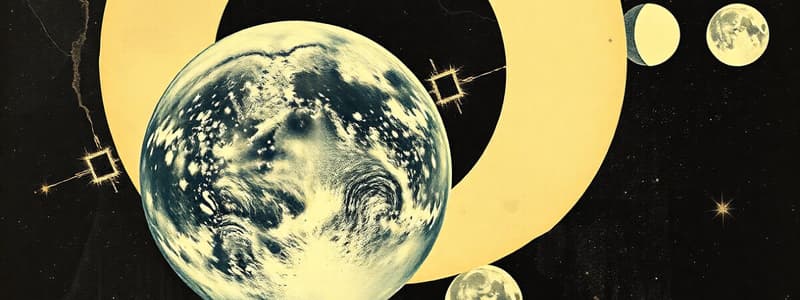Podcast
Questions and Answers
What is the period of Earth's rotation?
What is the period of Earth's rotation?
- 365 hours
- 12 hours
- 24 hours (correct)
- 48 hours
Which of the following is NOT one of Johannes Kepler’s Laws of Planetary Motion?
Which of the following is NOT one of Johannes Kepler’s Laws of Planetary Motion?
- The Law of Ellipses
- The Law of Circular Orbits (correct)
- The Law of Equal Areas
- The Law of Harmonies
Which phase of the moon immediately follows the first quarter phase?
Which phase of the moon immediately follows the first quarter phase?
- Waning Crescent
- Waxing Gibbous (correct)
- New Moon
- Full Moon
How does the tilt of Earth's axis affect seasonal changes?
How does the tilt of Earth's axis affect seasonal changes?
Which constellation is known for its distinctive shape often associated with a hunter?
Which constellation is known for its distinctive shape often associated with a hunter?
The period of rotation for Earth is approximately 365 days.
The period of rotation for Earth is approximately 365 days.
Johannes Kepler formulated four laws of planetary motion.
Johannes Kepler formulated four laws of planetary motion.
The tilt of Earth's axis directly influences the amount of insolation areas receive.
The tilt of Earth's axis directly influences the amount of insolation areas receive.
In a total lunar eclipse, the Earth is positioned between the sun and the moon.
In a total lunar eclipse, the Earth is positioned between the sun and the moon.
There are five recognized phases of the moon in its cycle.
There are five recognized phases of the moon in its cycle.
Flashcards are hidden until you start studying
Study Notes
Constellations
- Orion: Consists of a prominent pattern of stars, including Betelgeuse and Rigel.
- Cassiopeia: Appears as a "W" or "M" shape.
- Ursa Major: Contains the Big Dipper, which is part of a larger constellation.
- Cygnus: Known for its prominent "cross" shape, including the star Deneb.
- Scorpius: Resembles a scorpion, with a prominent red star, Antares.
Earth's Rotation and Revolution
- Rotation: Refers to the spinning of Earth on its axis, resulting in day and night.
- Revolution: Refers to Earth orbiting the Sun, leading to a year.
- Rotation period: Approximately 24 hours.
- Revolution period: Approximately 365 days.
Kepler's Laws of Planetary Motion
- Law of Ellipses: Planets move in elliptical orbits around the Sun.
- Law of Equal Areas: A line connecting a planet to the Sun sweeps out equal areas in equal times.
- Law of Harmonies: The square of a planet's orbital period is proportional to the cube of the average distance from the Sun.
Seasonal Changes
- Earth's Tilt: Earth is tilted on its axis at 23.5 degrees.
- Insolation: The tilt causes varying amounts of direct sunlight (insolation) reaching different parts of the Earth, resulting in seasons.
Moon Phases
- Lunar cycle: The moon goes through a series of phases over roughly 29.5 days.
- Phases: New Moon, Waxing Crescent, First Quarter, Waxing Gibbous, Full Moon, Waning Gibbous, Last Quarter, Waning Crescent.
Solar and Lunar Eclipses
- Solar Eclipse: Occurs when the Moon passes between the Sun and Earth, blocking the Sun's light.
- Lunar Eclipse: Occurs when the Earth passes between the Sun and Moon, blocking the Sun's light from reaching the Moon.
Studying That Suits You
Use AI to generate personalized quizzes and flashcards to suit your learning preferences.




